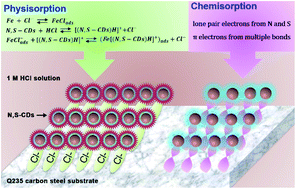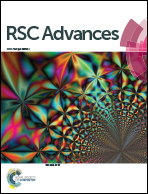Nitrogen and sulfur Co-doped carbon dots as ecofriendly and effective corrosion inhibitors for Q235 carbon steel in 1 M HCl solution
Abstract
Novel nitrogen and sulfur co-doped carbon dots (N,S-CDs) were synthesized via a hydrothermal procedure using citric acid (CA) and thiourea (TU) as precursors, and the corresponding corrosion protection performance was first investigated for Q235 carbon steel in 1 M HCl solution. Experimental results indicated that N,S-CDs as mixed-type corrosion inhibitors could effectively prevent Q235 carbon steel from corrosion in 1 M HCl solution, and the corrosion inhibition efficiency was improved with the increase in N,S-CD concentration. The maximum value was achieved at 400 ppm of N,S-CDs at 25 °C, which was approximately 96.6%, 94.6% and 90.55%, according to the potentiodynamic polarization curves, EIS results and weight loss measurement, respectively. Additionally, with the temperature ranging from 25 to 55 °C, the inhibition efficiency obtained from the weight loss measurement was enhanced from 90.55% to 94.04%. Such superior inhibition effect was assigned to the physisorption and chemisorption of N,S-CDs on the Q235 carbon steel surface, which was also be confirmed by XPS analysis. The adsorption of N,S-CDs onto a steel substrate conformed to the Langmuir adsorption isotherm.



 Please wait while we load your content...
Please wait while we load your content...